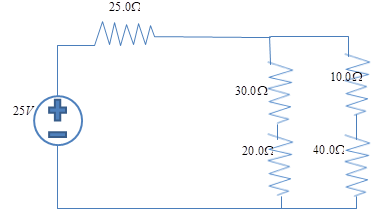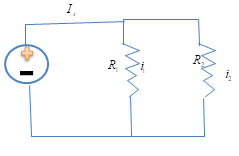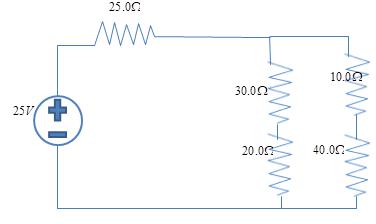
Using ohm's law, find the current through 25.0 ohm.
A. 1.0A
B. 1.5A
C. 0.5A
D. 2A
Answer
540.6k+ views
Hint: This question is based on the ohm's law, and the current division rule which is used to make the calculation easier. We will discuss both to get the answer. We will proceed by finding the source current first and then using the current division rule we will find the current through other elements of the circuit.
Complete step-by-step answer:

Ohm’s law states that the voltage or potential difference between two points is directly proportional to the current or electricity passing through the resistance, and directly proportional to the resistance of the circuit. The formula for Ohm’s law is V=IR. This relationship between current, voltage and relationship was discovered by German scientist Georg Simon Ohm.
Also , whenever current has to be divided among resistors in parallel, use current divider rule

$
{i_1} = \dfrac{{{R_2}}}{{{R_1} + {R_2}}}{i_s} \\
{i_2} = \dfrac{{{R_1}}}{{{R_1} + {R_2}}}{i_s} \\
$

Now the total resistance of the given circuit is
${\operatorname{R} _{eq}} = 25 + \dfrac{{50 \times 50}}{{100}} = 50$
Therefore, the current from the source end is given by
$
{I_s} = \dfrac{{{V_s}}}{{{R_{eq}}}} \\
{I_s} = \dfrac{{25}}{{25}} = 1A \\
$
As we have to find the current through the 25 ohm resistor, we know that the current in series remains the same and therefore the same source current will flow through the 25 ohm resistor.
Therefore the same source current will flow through the 25 ohm resistor.
Hence, the correct option is “A”.
Note- This law cannot be applied to unilateral networks. A unilateral network has unilateral elements like, diode, transistor, etc. Ohm's law is also not applicable for non - linear elements. Also the ohm’s law is only applicable to linear elements. An element is said to be linear if it satisfies the principle of homogeneity and superposition.
Complete step-by-step answer:

Ohm’s law states that the voltage or potential difference between two points is directly proportional to the current or electricity passing through the resistance, and directly proportional to the resistance of the circuit. The formula for Ohm’s law is V=IR. This relationship between current, voltage and relationship was discovered by German scientist Georg Simon Ohm.
Also , whenever current has to be divided among resistors in parallel, use current divider rule

$
{i_1} = \dfrac{{{R_2}}}{{{R_1} + {R_2}}}{i_s} \\
{i_2} = \dfrac{{{R_1}}}{{{R_1} + {R_2}}}{i_s} \\
$

Now the total resistance of the given circuit is
${\operatorname{R} _{eq}} = 25 + \dfrac{{50 \times 50}}{{100}} = 50$
Therefore, the current from the source end is given by
$
{I_s} = \dfrac{{{V_s}}}{{{R_{eq}}}} \\
{I_s} = \dfrac{{25}}{{25}} = 1A \\
$
As we have to find the current through the 25 ohm resistor, we know that the current in series remains the same and therefore the same source current will flow through the 25 ohm resistor.
Therefore the same source current will flow through the 25 ohm resistor.
Hence, the correct option is “A”.
Note- This law cannot be applied to unilateral networks. A unilateral network has unilateral elements like, diode, transistor, etc. Ohm's law is also not applicable for non - linear elements. Also the ohm’s law is only applicable to linear elements. An element is said to be linear if it satisfies the principle of homogeneity and superposition.
Recently Updated Pages
Master Class 12 Biology: Engaging Questions & Answers for Success

Master Class 12 Physics: Engaging Questions & Answers for Success

Master Class 12 Economics: Engaging Questions & Answers for Success

Master Class 12 Maths: Engaging Questions & Answers for Success

Master Class 11 Economics: Engaging Questions & Answers for Success

Master Class 11 Accountancy: Engaging Questions & Answers for Success

Trending doubts
Which are the Top 10 Largest Countries of the World?

Differentiate between homogeneous and heterogeneous class 12 chemistry CBSE

Why is the cell called the structural and functional class 12 biology CBSE

a Tabulate the differences in the characteristics of class 12 chemistry CBSE

Who discovered the cell and how class 12 biology CBSE

Draw a labelled sketch of the human eye class 12 physics CBSE




